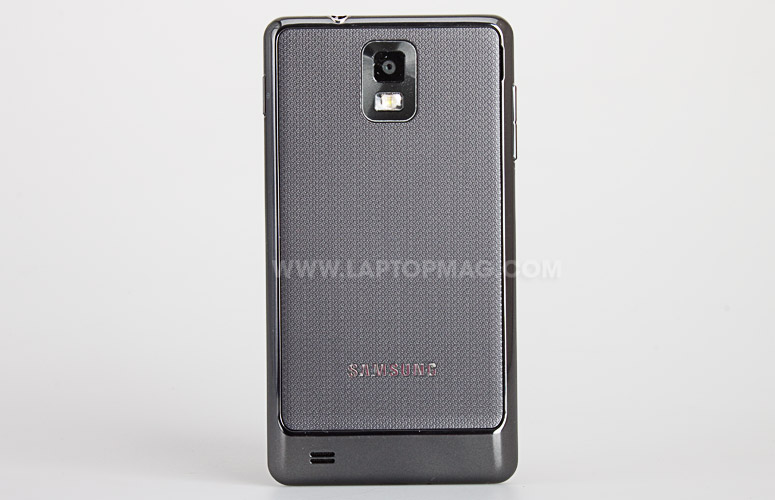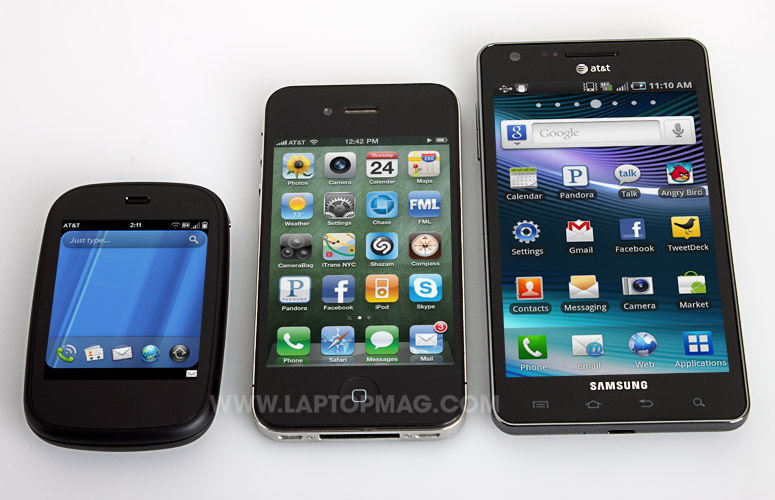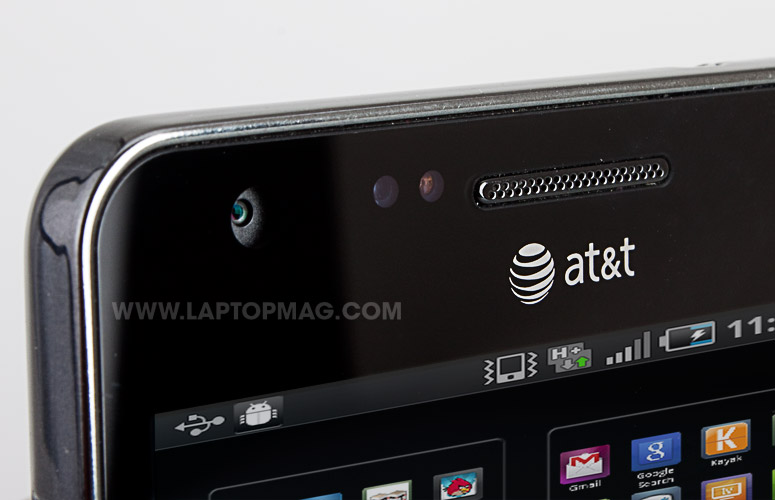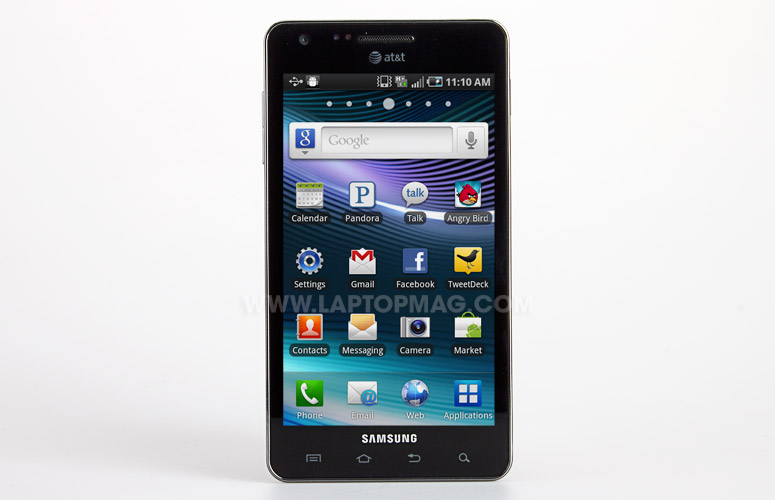Laptop Mag Verdict
The Infuse 4G's mammoth 4.5-inch display has some benefits, but it's held back by AT&T's slow network.
Pros
- +
Large, bright display
- +
Above-average battery life
- +
Light for its size
- +
Good call quality
Cons
- -
Poor "4G" speeds
- -
Difficult to use with one hand
- -
Need to plug in power for HDMI out
Why you can trust Laptop Mag
Even by the latest smartphone standards, the Samsung Infuse 4G's 4.5-inch screen is mammoth. Not since the Dell Streak has it felt more natural to hold a phone in landscape, rather than portrait, mode. But it's not just the size of the screen that counts; it's what you do with it. And the Infuse 4G backs up its large canvas with a zippy 1.2-GHz processor, a sharp 8-megapixel camera, and HDMI output. Samsung even throws in a $25 credit for downloading movies through its Media Hub store (at least for the first 500,000 buyers). Is this larger-than-life handset the best AT&T has to offer Android lovers?
Design
There's no mistaking the Infuse 4G's size. At 5.2 x 2.8 inches, it's longer and wider than just about every other phone on the market. By comparison, the T-Mobile G2x is 4.9 x 2.5 inches, and the Thunderbolt is 4.8 x 2.4 inches. Yet, the Infuse is comparatively thin, just 0.35 inches thick. As a result of its footprint, it feels lighter than its 4.9-ounce weight would suggest. Indeed, the diminutive HP Veer 4G, which weighs more than an ounce less, feels nearly the same in your hand.
While the face of the Infuse 4G is dominated by the glossy touchscreen, the back has a textured panel that adds a dash of class while keeping fingerprints away. Another nice touch is the dark chrome-colored plastic edge. The bottom of the Infuse's back has a slight bulge to house the speaker, but it's much less obtrusive than the larger bulge on the upper back of the Droid X or the chin on the Samsung Droid Charge.

Click to enlarge
It's nice having all that screen real estate, but the width of the Infuse 4G makes it a little difficult to hold. Even with large hands, we weren't able to curl our fingers and grip the phone as tightly as we wished while selecting items on the far left side of the screen, which made it feel a little precarious.
There's no HDMI port, as on the T-Mobile G2x, but the Infuse 4G comes with an adapter for its USB port that lets you connect the phone to a TV via HDMI. Considering its size, we also wish this device had a kickstand like the Thunderbolt.

Click to enlarge

Click to enlarge

Click to enlarge

Click to enlarge
Keyboard
One benefit of having a phone as wide as the Infuse 4G is that even in portrait mode it feels more natural to use the keyboard with two thumbs rather than one. As with other Galaxy S smartphones, we appreciated the light haptic feedback, which let us know when we'd hit a letter.
A plethora of keyboard options are available: Users can choose from Android, Samsung, and Swype (the latter of which lets you drag your finger from letter to letter to type words). The Samsung keyboard offers more settings than are usually found on its smartphones. For instance, there are four different portrait keyboard layouts, including two that recognize handwriting. Instead of a keyboard, a box divided into four quadrants lets you draw letters and numbers using your finger. However, it didn't prove very accurate when we tried writing at a normal speed. The Infuse 4G misinterpreted our scribbling so much that what we wrote looked like gibberish.
Display
Of course, the 4.5-inch display on the Infuse 4G is this phone's foremost feature. The screen uses Super AMOLED Plus technology, which packs in 50 percent more subpixels. This means that everything looks a little bit sharper and brighter. Looking closely at icons, we saw less graininess. Just as important, photos and videos really pop on this display. Plus, viewing angles are wide, and it's easy to see the screen in sunlight.

Click to enlarge
However, the Infuse 4G's resolution of 800 x 480 is lower than some competing phones. The Motorola Atrix 4G, for example, sports a 965 x 540-pixel display, as does the Samsung Galaxy SII (which isn't yet available for sale in the U.S.).
As mentioned, we were able to output the Infuse 4G's display to a larger monitor using the included USB-to-HDMI adapter. We liked the fact that the adapter has a full-size HDMI port, but we didn't like that we also had to plug the Infuse 4G's microUSB charger into the adapter as well. We much prefer Tegra 2 phones, which don't require this extra step. Still, once connected, we were able to play games, as well as watch movies and photos.
Interface
Click to enlargeThe Infuse 4G runs Android 2.2 with Samsung's TouchWiz interface. As with other phones, you get seven customizable home screens; a pinch gesture brings up all seven at once, and performing the same gesture with the applications open does the same. Widgets include Days (a diary), Program Monitor, and Social Updates for checking Facebook and Twitter.
Samsung includes some of its own apps on the Infuse 4G such as AllShare, Media Hub, Music Player, and Video Player, as well as Task Manager, Voice Recorder, and Write and Go. AT&T apps include AT&T Code Scanner (a bar code reader that lets you compare prices online), AT&T FamilyMap ($9.99 per month), which lets you locate family members who are also using AT&T phones, AT&T Navigator, and U-verse Live TV (which only works over 4G).
Performance
The 1.2-GHz Samsung processor in the Infuse 4G is fairly fast, allowing us to perform pinch-to-zoom gestures and screen rotations quickly and smoothly. Still, there were a few glitches; when we were playing Medieval Castle Defense, action would freeze for a split second if there were many characters on-screen.
The Infuse 4G's Linpack score of 16.32 is higher than the smartphone average (12.2), but about half that of the T-Mobile G2x (34.9) and the Atrix 4G (32.7), both of which use Nvidia's dual-core Tegra 2 CPU. In terms of graphics performance, the Infuse 4G's An3DBench score of 7,128 is about 1,000 points above average. It also beats out the Atrix (6,305), but it comes in well below the G2x (11,074).
Data Speeds
It's becoming insulting that AT&T keeps branding phones with the 4G moniker when it's only offering 3G speeds in major metro areas. The Infuse 4G is the latest example. When we could get a decent signal, web pages took longer to load than on other phones, and too many times, we received a network error.
AT&T's HSPA+ can theoretically notch download speeds of up to 21 Mbps, but we didn't get anywhere near that. Using the Speedtest.net app, download throughput averaged 2.6 Mbps, and topped out at 3.7 Mbps. That's roughly the same as the Atrix 4G, and less than half the G2x's speed (6.7 Mbps).
Uploads were the same story: The Infuse 4G averaged 535 kbps, and ranged from 116kbps to 1190 kbps. By comparison, the G2x averaged 1.7 Mbps, more than twice as fast.
The Infuse 4G also took slightly longer than average to load web pages; Laptopmag.com loaded in an average of 15 seconds, the mobile version of ESPN.com took 9 seconds, and the mobile NYTimes site took an average of 4 seconds.
Like most smartphones, the Infuse 4G supports tethering via USB or wirelessly for up to five devices. However, this requires a Tethering/Mobile Hotspot plan, which costs an additional $20 per month. Until AT&T's speeds improve, we wouldn't pay for it.
Battery Life
Despite its large screen, the Infuse 4G has good endurance. On the LAPTOP Battery Test (web surfing via 4G), the phone lasted 6 hours and 7 minutes. That's about the same time as the Galaxy S 4G and half an hour longer than the smartphone average, but about 40 minutes shy of the Incredible 2. We were able to get through a day of surfing the web, using the phone as a GPS, and playing some games before having to recharge the Infuse 4G.
GPS
One nice thing about the Infuse 4G's huge screen is that it provides a large canvas for navigation. We can recall not too long ago that dedicated GPS devices with screens this size commanded a premium. As mentioned, the Infuse 4G comes with AT&T Navigation ($9.99 per month), but we found the free Google Navigation app just as helpful. While it took a little longer to acquire a solid fix (about 30 seconds to a minute or two), we liked how much of the map we could see on the Infuse's screen.
Click to enlarge
Camera
The 8-MP camera on the Infuse 4G took crisp pictures at a max resolution of 3264 x 2448 pixels, and we like the controls for adjusting ISO, metering, anti-shake, and blink detection. However, we wish it had HDR like the iPhone. When we took a picture of the Empire State Building against a bright blue sky, either the upper part of the tower was properly illuminated while street level was too dark, or the top of the building would be washed out if the street was bright. The flash was fairly bright, illuminating a close subject in a dimly lit room.
Click to enlarge
The Infuse 4G shoots video at a max resolution of 720p, which is good, but not as high as the T-Mobile G2x' 1080p video camera. Movies were smooth, detailed, and rich in color, but we'd advise against using the digital zoom; it was jerky.
Our biggest complaint would be that the lens should also be moved in further. Its placement close to the left edge in landscape mode meant that our finger often covered the lens when we were shooting. We kept wiping it clean.

Click to enlarge
Call Quality
Samsung's noise cancellation on the Infuse 4G was remarkably good. When we were standing on a street in midtown Manhattan, the noise from a truck rumbling by was almost completely eliminated, and a caller could hear us clearly. The caller also came through well on our end, and we didn't feel all that ridiculous holding the large Infuse to the side of our head.
Verdict
The Samsung Infuse 4G has plenty to offer--a sleek design, a good camera, and a big and vibrant screen. However, even though this device is thin and light for a 4.5-inch smartphone, using it one-handed can feel awkward because of the large footprint. What's more, having extra real estate makes waiting for content to load over AT&T's network all the more agonizing. For Android fans, we prefer the Motorola Atrix 4G on AT&T, which sports a more powerful Tegra 2 processor and a smaller but higher-resolution display. And if you're not wedded to Ma Bell, consider the T-Mobile G2x, which offers real 4G speeds plus dual-core power. Still, if you truly believe bigger is better, the Infuse 4G is definitely worth a look. It's 10 times better than the original Dell Streak.

Click to enlarge
Michael was the Reviews Editor at Laptop Mag. During his tenure at Laptop Mag, Michael reviewed some of the best laptops at the time, including notebooks from brands like Acer, Apple, Dell, Lenovo, and Asus. He wrote in-depth, hands-on guides about laptops that defined the world of tech, but he also stepped outside of the laptop world to talk about phones and wearables. He is now the U.S. Editor-in-Chief at our sister site Tom's Guide, where he oversees all evergreen content and the Homes, Smart Home, and Fitness/Wearables categories for the site..
